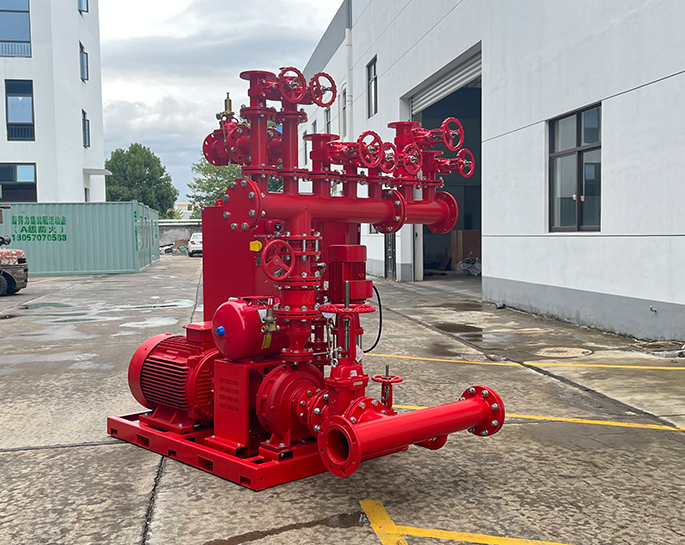What are the considerations for selecting the appropriate size and capacity of a firefighting pump?
Feb 21, 2024
Share:
Selecting the appropriate size and capacity of a firefighting pump is crucial to ensure effective fire protection. Several factors need to be considered during the selection process:
1. **Water Supply**: Determine the available water sources for the firefighting pump, such as municipal water supply, reservoirs, tanks, or natural bodies of water. The pump's capacity should match or exceed the water supply to maintain adequate pressure and flow rates during firefighting operations.
2. **System Demand**: Calculate the maximum water demand of the fire protection system based on factors such as the size of the protected area, the type of hazards present, and applicable fire codes and regulations. The pump's capacity should meet or exceed this demand to ensure sufficient water flow for firefighting purposes.
3. **Pressure Requirements**: Consider the required operating pressure for the fire protection system, including factors such as elevation changes, friction losses in pipes and fittings, and the need to overcome obstacles or reach distant areas. The pump should be capable of providing the necessary pressure to deliver water effectively throughout the system.
4. **Hazards and Risks**: Assess the specific fire hazards and risks present in the facility, such as the types of materials stored or processed, the potential for fire spread, and any specialized firefighting requirements. Choose a pump size and capacity that can address these hazards effectively, such as high-flow pumps for large industrial facilities or pumps with corrosion-resistant materials for corrosive environments.
5. **Redundancy and Backup**: Consider the importance of redundancy and backup systems to ensure reliability and continuity of firefighting operations. In critical applications, such as in high-risk industrial settings or facilities with limited water availability, it may be necessary to install multiple pumps or backup power sources to maintain firefighting capabilities during emergencies.
6. **Space and Installation Constraints**: Evaluate the available space for installing the firefighting pump and associated equipment, as well as any restrictions or limitations that may affect the pump's size, configuration, or installation method. Choose a pump that can be accommodated within the available space while meeting the performance requirements of the fire protection system.
7. **Maintenance and Lifecycle Costs**: Consider the long-term maintenance requirements and lifecycle costs associated with the firefighting pump, including factors such as maintenance intervals, spare parts availability, energy efficiency, and overall reliability. Select a pump from a reputable manufacturer with a track record of quality and reliability to minimize ongoing maintenance and operating expenses.
By carefully considering these factors, facility managers, engineers, and fire protection professionals can select the appropriate size and capacity of a firefighting pump to ensure reliable and effective fire protection for industrial facilities.

1. **Water Supply**: Determine the available water sources for the firefighting pump, such as municipal water supply, reservoirs, tanks, or natural bodies of water. The pump's capacity should match or exceed the water supply to maintain adequate pressure and flow rates during firefighting operations.
2. **System Demand**: Calculate the maximum water demand of the fire protection system based on factors such as the size of the protected area, the type of hazards present, and applicable fire codes and regulations. The pump's capacity should meet or exceed this demand to ensure sufficient water flow for firefighting purposes.
3. **Pressure Requirements**: Consider the required operating pressure for the fire protection system, including factors such as elevation changes, friction losses in pipes and fittings, and the need to overcome obstacles or reach distant areas. The pump should be capable of providing the necessary pressure to deliver water effectively throughout the system.
4. **Hazards and Risks**: Assess the specific fire hazards and risks present in the facility, such as the types of materials stored or processed, the potential for fire spread, and any specialized firefighting requirements. Choose a pump size and capacity that can address these hazards effectively, such as high-flow pumps for large industrial facilities or pumps with corrosion-resistant materials for corrosive environments.
5. **Redundancy and Backup**: Consider the importance of redundancy and backup systems to ensure reliability and continuity of firefighting operations. In critical applications, such as in high-risk industrial settings or facilities with limited water availability, it may be necessary to install multiple pumps or backup power sources to maintain firefighting capabilities during emergencies.
6. **Space and Installation Constraints**: Evaluate the available space for installing the firefighting pump and associated equipment, as well as any restrictions or limitations that may affect the pump's size, configuration, or installation method. Choose a pump that can be accommodated within the available space while meeting the performance requirements of the fire protection system.
7. **Maintenance and Lifecycle Costs**: Consider the long-term maintenance requirements and lifecycle costs associated with the firefighting pump, including factors such as maintenance intervals, spare parts availability, energy efficiency, and overall reliability. Select a pump from a reputable manufacturer with a track record of quality and reliability to minimize ongoing maintenance and operating expenses.
By carefully considering these factors, facility managers, engineers, and fire protection professionals can select the appropriate size and capacity of a firefighting pump to ensure reliable and effective fire protection for industrial facilities.


.png)
.png)

.png)


